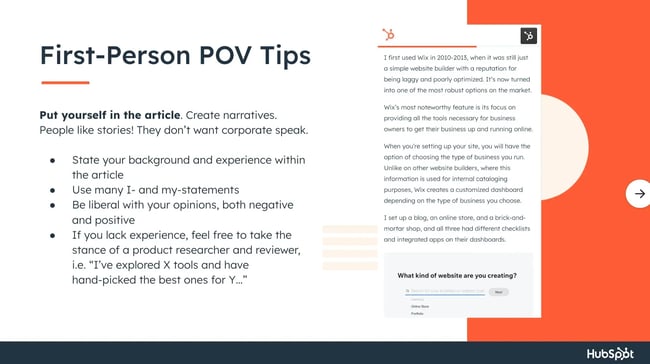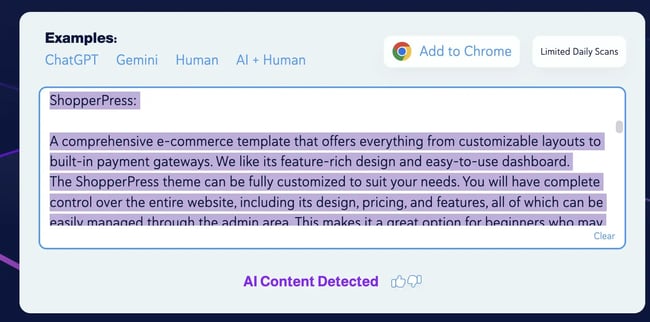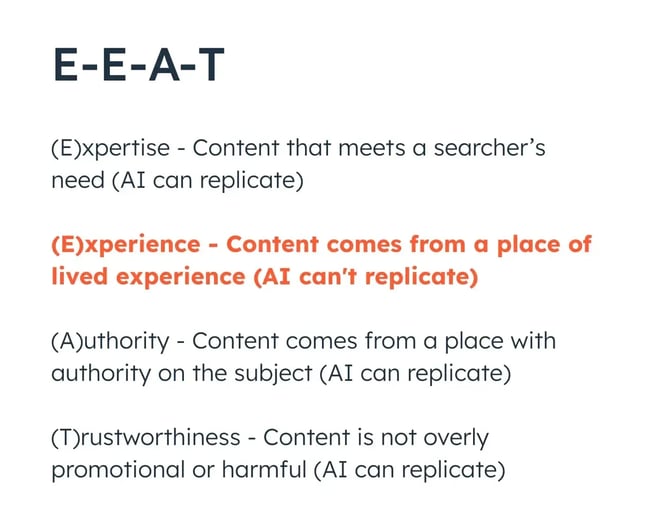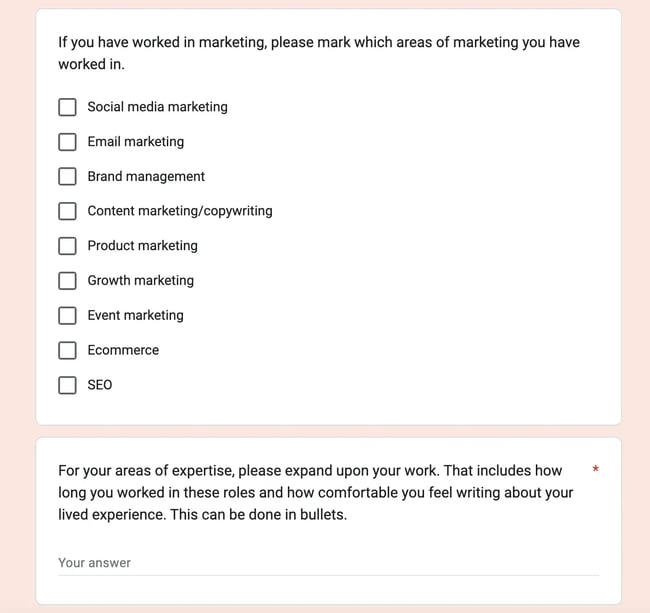When I started working with freelancers, I’d experience a sinking feeling when a first draft hit my inbox. Would this piece be any good? Or, would I be rewriting an entire article myself to get something usable?
Or perhaps, I found a gem — a freelancer who would make my day with a light edit, strong writing, and a grasp of the subject matter at hand.
I would do anything in my power to make them happy. Please don’t leave me, I’d whisper to my laptop as I typed a praise-filled thank you email.

Four years later, I’ve cracked the code. I now run HubSpot’s Freelance Network, a contract program with over 40 writers.
My team creates over 800 pieces every year. I feel like I have a collection of rare gems, each with their own specialized insights that can help our audience grow.
The best part? I’m finally ready to share how I made this program a reality.
But first, here’s a little about me. My name is Kaitlin. I’m a journalist by trade who’s made the transition into the wonderful world of content marketing. So, my first role working with freelancers was in that past life at business publications.
In 2022, I was recruited by HubSpot for a brand-new challenge. My mission was to build a robust group of freelancers to serve HubSpot’s full portfolio of English blogs.
Infrastructure is everything.
When I first joined HubSpot, I was introduced to 11 freelance writers. I also inherited a standard operating procedure (SOP) document that described how to write new posts and update existing ones. The rest was mine to build.
I spent most of my days creating the foundation to support freelancers at scale.
Before I joined the team, freelancers were an extra task that our writers and blog managers leveraged only when needed. Infrastructure was needed to standardize these processes.
Here’s what I worked on.
Investing in Personal Training
The SOP document I received on my first day was essential for helping me get oriented in my role. However, the document was 21 pages long.
Sure, all the information was helpful, but I knew our writers would skim the document at best. They had dozens of clients each and wouldn’t spend the afternoon reading the text closely over coffee.
So, we had to adjust. I split the SOP into two shorter documents — one for updates and the other for new posts. I then set up a learning management system with an onboarding course.
New writers would need to sign in and watch short videos about how to write for HubSpot, who our personas are, and how to use admin tools like our invoicing system.

I could see who actually completed the course and remind others that this video series was an essential part of onboarding.
The result was a lot faster than reading the document, and I was able to guarantee compliance. Plus, I still sent along SOP documents so the writers could review them at any time.
I then took training one step further. For each new writer, I created a customized Loom video about their first posts. In it, I would review every element of their assignment in Asana, our project management platform, explaining any HubSpot-specific jargon and how we expect submissions to be formatted.
When I started this process, I found that I received fewer email inquiries about simple questions. Instead, we were able to focus on hard-hitting editorial needs.
Beyond that, a few writers have told me this was the most organized onboarding process they’ve experienced, which always gives me a warm fuzzy feeling.
Making Processes Light-Touch
Freelance writers are busy people, always on the cutting edge of an article or blog post. As a program manager, I want to make sure they can focus on what they love — writing — and breeze through any administrative challenges.
I began standardizing our assignments. I linked everything our writers would need, like relevant documents and resources, in an email sent at the start of every month. Each assignment had a clearly marked price, a link to an Asana task card with instructions, and a link to a Google Doc where they could write.
Writers no longer had to copy, paste, and format walls of text when working on updates. They didn’t have to dig in the annals of our website for relevant data points. They could peruse information in one place and then get to writing.
Pro tip: This may seem like a simple step, but as a leader, you should remove redundant, unnecessary tasks from your writers. You know your internal systems best. Make them as easy and light-touch as possible for your freelancers.
Rethinking Content Briefs
Finally, I completely shifted how we wrote content briefs.
As a team, we’ve tracked our blog assignments in Asana since the very beginning.
However, historically, the assignment instructions were short bullet points intended for in-house writers. For example, we would ask them to shorten intros, write new sections, or add links to relevant product mentions.
Those bare-bones briefs worked for in-house writers who spent months out of their role onboarding. However, freelancers needed more details to produce their best work.
I began translating posts for our external team. If an instruction had jargon, like “remove additional parameters to internal links,” I would reformat the bullet into standard language, like “remove UTM tracking codes from links.”
For new posts, I also began creating proposed outlines. That included how long intros should be, what subheadings we’d want to include, and how each section should be formatted.
The result? First drafts started to arrive in better shape, requiring fewer edits and fewer rounds of revisions from the writers.
.webp)
With these elements in place, I was able to focus on staffing the program. I put out calls on LinkedIn for writers and vetted their portfolio pieces.
As the number of assignments I received grew, I brought writers with relevant B2B experiences on board.
Here are the ratios I used:
- 40 pieces for 11 freelance writers
- 60 pieces for 30 freelance writers
- 80 pieces for 50 freelance writers
That growth would have caused chaos without a strong foundation.
The Rise of AI — and Squashing Get-Rich-Quick Schemes
In November 2022, ChatGPT launched to the public. Anyone could write a short text prompt and generate … well, anything. That includes full-length blog posts with proper headings.
Yes, AI hallucinated, coming up with fake facts. Sometimes, the output sounded stilted, but that never stops grifters.
Shortly after ChatGPT launched, my TikTok was filled with get-rich-quick gurus selling courses on how to make passive income by freelance writing. Just type a prompt, have AI generate an article, and send it to program managers like me.
Sure enough, I started to receive pieces that were a little fishy.
That source’s company couldn’t be called “ABC Web Design Company.” The writing seemed too generic, with no distinct voice.
I began to feed submissions into Copyleaks, a plagiarism and AI content checker.
And guess what I found? Anywhere from 60% to 90% of the text in these posts was generated by AI.

In March 2023, I sent out a memo to our writers that stated AI could only be used in the research and brainstorming phases of writing.
For pieces that had already been submitted, I reached out if over 10% of the text was flagged as AI-generated. Writers had seven days to make changes to the AI portions of their writing.
If changes weren’t made within this timeframe, our editors would step in to rewrite the sections. In those cases, the editor received the byline for the article instead of the writer.
For all pieces assigned since March 2023, we implemented a zero-tolerance policy for AI-generated or plagiarized work. If a piece came back flagged, we required a rewrite of the post before payment was issued. We then removed the writer from our roster.
To many, this might seem strict. However, I believe that preserving human insight is essential to earning traffic.
Every two days, people create enough content to surpass the world’s population, according to Neil Patel’s session at our most recent INBOUND conference.
Of that, around 94% of web pages that rank on Google get zero traffic. AI exacerbates this challenge.
We built a program that pays people fairly for their human writing, filled with real tips and helpful advice.
AI-generated content could never be remarkable. It’s the average sum of all the writing on the internet. To earn engagement, I know we need that human touch.
Freelance Network 2.0: Pivoting to E-E-A-T
In April 2023, the content marketing realm shifted again, this time with an update to Google’s Core Algorithm.
One of the biggest changes was an increased emphasis on E-E-A-T — or expertise, experience, authority, and trustworthiness.

Instead of AI-driven content, Google began to prioritize work crafted from lived-experience. That means lots of “I” statements, personal anecdotes, and pro tips that could never be replicated by a content generalist.
Sites across the internet lost traffic in droves, including yours truly — the HubSpot Blog. We had to completely transform the Freelance Network in response.
To start, I needed to see who on the team was a secret subject matter expert (SME). That means I was looking for freelancers who had a job as a marketer, customer service representative, sales person, or web developer.
To do so, I sent out a survey to our current writers asking which fields they worked in previously and for how long.

I found that a number of our writers had experience that already made them SMEs. One of our writers spent years as a support rep, making him a great fit for Service Blog articles.
Another had spent eight years at a marketing agency, specializing in public relations and crisis management.
With this information at hand, I could pair our writers with assignments that matched their lived experiences. They could then weave in relevant stories and helpful tips a general content writer wouldn’t know.
Next, I shared the value of gathering quotes. We still had a number of great writers who could communicate complex ideas but lacked direct, professional experiences in the subjects we cover.
To fill the gap, these writers would need to act like journalists, gathering quotes from professionals in the field.

I asked who felt comfortable reaching out for quotes.
Our team began making connections to internal HubSpotters who could add their perspectives as sources in posts.
Beyond that, we shared our favorite resources (like Help a B2B Writer and Featured) to help our writers still making the transition.
After that, I had to find new writers who were active practitioners to staff the Blog. While quotes are helpful, there’s still a real place for thought leadership and how-to articles from people who lived the experience. I booked a meeting with each Blog’s managing editor to ask what they looked for in an SME.
Let’s use our Sales Blog as an example. Jay Fuchs, Sales Blog editor at HubSpot, said his ideal SME had spent time as a business development representative and an account executive. Management experience in the B2B space was a bonus.
I turned our conversation into a scorecard to avoid hiring bias and put out a call for writers.

That’s how we found Mark Burdon and Michael Welch, two of our SMEs on the Sales Blog. They’re able to share the experience of tracking sales metrics and running teams. They complement our staff’s journalistic efforts with wisdom straight from the source.
My 5 Biggest Learnings
So far, I covered the broad plays we made to build the Freelance Network. But I’ve learned so much over the last two-and-a-half years. Here are the five biggest lessons that I believe can help anyone running a freelance program.

1. You need to pay fair.
In the world of freelance writing, you often get what you pay for. In my experience, a low price tag leads to sloppy work. Or even worse, your writers may churn. So, we need to pay competitively and stay in line with industry trends.
If you have to test tools for an in-depth review or gather quotes, I’d plan for a higher price tag. I also encourage my writers to tell me if a post is more work or much longer than we expect. That allows me to adjust the price accordingly.
2. Editors are your make-or-break.
I am so fortunate to work with a team of great freelancers. However, even the best writers make mistakes. That can range from clunky sentences to typos or missing alt text to improper formatting.
That’s where editing comes in.
In addition to our freelance writers, the Freelance Network has two contract editors, Taylor Cromwell and Margaret Cousino. They make sure that all of the requests in the brief are fulfilled and that the final drafts are error-free.
Beyond that, our internal Freelance Network team does a quality review.
All of our freelancers — writers and editors — have multiple clients with different style guides. I advocate for having a final set of eyes within your organization.
Trust me, your internal team will catch the last little things others may miss.
3. Don’t staff what you don’t know.
In 2022, I was tasked with finding writers who could create coding tutorials for our Website Blog. I put out a call on LinkedIn and found a few developers.
Their work seemed good enough to me. The problem? I don’t know how to code and couldn’t fact-check their writing.
That was my biggest failure as a program leader. We had sub-par content that we had to shelve. Some of it never got published.
My biggest learning: Don’t find writers for subject areas you know nothing about.
I’ve started tackling this challenge again, honing in on HTML and CSS technical writers. However, I’m working hand-in-glove with Jamie Juviler, the Website Blog’s lead editor.
I’m playing the role of a recruiter, reaching out to potential candidates. Jamie actually reviews their work and decides who’s proficient enough to stay.
4. Feedback makes the world go round.
My program makes at least 60 assignments a month. Lately, we’ve been doling out upwards of 100 pieces. I’ve always found it difficult to give feedback with such lofty goals. That’s why I’m so grateful for my colleague Marja Vitti.
Marja joined our team in March 2024. Since then, she’s implemented a feedback program that allows us to give kudos for great work and correct inconsistencies early.
Our editors now write comments throughout the submitted Google Doc and tag the writer for review. Then, we make another clean copy and send it to our internal blog team managers for upload.
The writers get helpful feedback. Our property owners internally get an easy-to-read, easy-to-upload version of the text. It’s a win-win.
This system has proved especially helpful for our subject matter experts. They’re great writers with unique insights in their fields. However, they often don’t have a technical SEO background.
This commenting system allows them to learn as they grow with us.
5. Sometimes, you have to break up.
Not every writer is the right fit. In today’s landscape, you may have to say goodbye to your content generalists in favor of subject matter experts.
I’ve had to write many breakup emails in this role. It’s my least favorite part of my job, but sometimes, it’s essential.
You may have a writer that’s always late. Or perhaps, they can’t adapt to your new EEAT-driven strategy, even with all your training resources.
Your team should be lean and filled with great writers. You’ll need to say goodbye to those who don’t make the cut. And, that’s okay.
You’re Not Running a Farm
If I wanted to farm, I’d buy chickens! Horrible jokes aside, running a content farm sounds appealing on paper. You can find content generalists, pay them the bare minimum, and play the volume game. To me, that’s a huge mistake.
Your audience wants human insights from subject matter experts — preferably people who have spent years working in the field you cover.
We also know that Google rewards expertise under its E-E-A-T formula. So, even if you’re operating at a smaller volume, what you do create will have more impact.
If you need your own Freelance Network on a tight budget, here’s what to do:
- Find SMEs in your field who write insightful LinkedIn articles or posts for their company blog.
- Get them to write pieces based on their lived experiences, with anecdotes and their pro tips.
- Publish and promote their work.
- (Leave completely AI-generated posts behind.)
I don’t think of creating content with freelancers like farming. Instead, I think of myself as a museum curator, finding valuable gems and displaying them for the world to see.
Good luck! I hope you find as much joy as I did as you curate your own museum.
![]()
این خبر را در ایران وب سازان مرجع وب و فناوری دنبال کنید
جهت دانلود و یا توضیحات بیشتر اینجا را کلیک نمایید